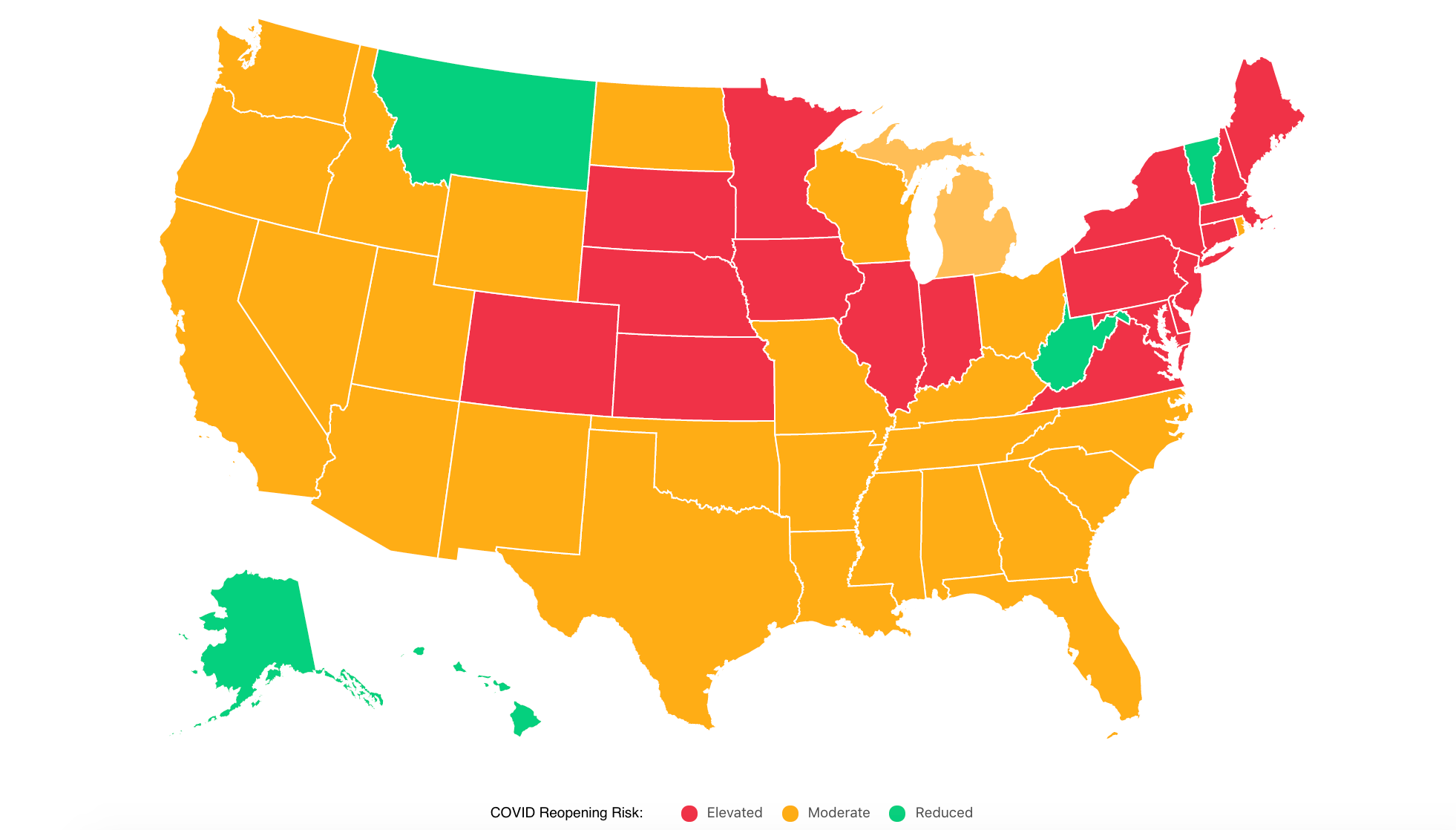What are the symptoms of COVID-19?
How do I file for unemployment?
Do I need to wear a mask?
Over the last few months, we’ve been collectively asking questions we probably never imagined having to type into our search bars. We’re reminded of the grim reality of our situation every time we write those first few words in Google: “How do I…” “When can we…” “How many…”
But as I write this, the first question on mine and many of our minds is, “Is my community ready to reopen?”
That’s exactly the question Covid Act Now is trying to answer for every state and county in America.
Covid Act Now is a multidisciplinary team of technologists, epidemiologists, health experts, and public policy leaders working to provide disease intelligence and data analysis on COVID-19 in the U.S. They’re volunteering their time and talents to create an objective data model that can help figure out whether it’s safe for regions to reopen based on three criteria:
Are COVID-19 infections declining?
Are we testing enough?
Can our hospitals handle the surge?

Head to Covid Act Now to use the interactive map and view your state’s projections.
Since publishing the first version of the model in late March, more than 10 million people have used it. Covid Act Now is also personally engaging with decision-makers at every level of government, from state and local leaders to the military.
And that’s where Front comes in.
Early on during the COVID-19 crisis, we set out to help teams working on direct aid and response make a greater impact. We started offering Front for free to organizations responding to coronavirus for a year. We’re now serving over 25 teams around the world, from volunteer health workers coordinating treatment to multidisciplinary orgs like Covid Act Now.
I had a chance to chat over Zoom with Hannah Lee, who runs Covid Act Now’s front end support, and their Policy Lead, Representative Jonathan Kreiss-Tomkins of the Alaska State Legislature. I wanted to learn more about the mission and find out how Front is helping Hannah and Jonathan make a greater impact.
You can read our lightly edited conversation below.
Matthew Klassen
Could you start by telling me a bit about Covid Act Now — the mission, how it got started, and what sets it apart from other models and prescriptive tools?
Hannah Lee
Covid Act Now started off when our friend Max [Henderson, CEO and ex-Google Data Scientist] started putting together spreadsheets, think back of the hand paperwork, to figure out when we would start running out of ICU or hospital bed capacity if we allowed the disease to continue to infect people. And then it grew from there. It was completely grassroots. It went from a question out of curiosity and concern to now we have this information that actually seems quite useful, so they [the founding team] thought, “How do we start spreading the word on what’s happening so that people can start enacting policies that would help stop the spread of COVID-19?”
Matthew Klassen
Are you doing this all on a volunteer basis?
Hannah Lee
Yes, everyone’s a volunteer. I had already left my job at Google, so I was able to put in full time to this effort. Actually, a lot of volunteers are in a similar situation or have been able to get the okay from their companies to work on this with 50 percent of their time. But most of us are almost full-time volunteers.
Matthew Klassen
And how have you been using Front to coordinate your team?
Hannah Lee
We use it primarily for inbound questions by the general public as well as partnerships with states and counties.
Our go-to-market team is broken up into a few different functions including social media, support, and partnerships.
I work specifically with the “T1” type of support: the general public will write in or tweet at us or send us Facebook messages. We field general inquiries about Covid Act Now, answer questions about the model, and take feedback and product requests that circle back to our product and engineering teams.
Our Partnerships team is more of the “Business Development” function who actually works with counties, cities, and state level epidemiologists or decision makers to help send them the information that they need. They’ll tell us, “We’re looking at adding in this many more hospital beds, what do you think? Or, “We’re going to enact shelter-in-place or stay at home today. What’s the impact there?”
We have different tiers of support and use Front to manage communications to external users and comms to our “higher-touch” folks.
Matthew Klassen
It sounds like you’re treating this almost as if it’s a support function, even though it’s probably really different than typical tech support. For instance, when you get questions from people who are asking about something that’s potentially pretty prescriptive, like, “Should we open?” What’s your process for finding out that answer and getting the right information back to them?
Hannah Lee
I think of it as support for states and counties to make the best decision. Our team is made up of data scientists as well as actual epidemiologists so their [the state or county’s] questions go to the modelers and when we present the data back to the state epidemiologist or county public health official, it’s very matter of fact. We’re not trying to sway them one way or another. We want to present them with the best information. Our team believes that policy makers should look at more than just one model.
I think of it as support for states and counties to make the best decision.
— Hannah Lee, Support Lead
We also use Front as our mode of outreach. JKT [Jonathan Kreiss-Tomkins] is actually a state senator of Alaska, and has a lot of contacts within the governmental world. And so either we know a person, we reach out to them, and then we use Front to do comms like follow up. Or people will write in. For example, today we had someone from the city of Las Vegas ask for some reopening data points from us. “This is when we’re looking to open up. Can you give us some feedback or some different scenarios of what can happen?”
Matthew Klassen
Are you using mostly the shared inbox to that? Or are you also using rules or message templates?
Hannah Lee
We definitely use a lot of message templates. I actually have a background in customer support and operations, so we use category tagging, priority tagging, and we have message templates for general inquiries. We have set up some rules, but don’t use those as often because we have different shared inboxes for different case loads. And then we do a lot of commenting and tagging people in when we need to triage or share email drafts when we need to.
Matthew Klassen
Covid Act Now is very cross-disciplinary. You’ve got epidemiologists, data scientists, people in the political sphere as well. You’re coordinating people not just across distances while everybody’s working remotely, but coordinating across knowledge bases. What are the challenges and the solutions you’ve found?
Jonathan Kreiss-Tomkins
We’re a multi-disciplinary organization, we’ve got a modeling team, an engineering team, a political outreach team. And it’s a lot of people in different lanes of expertise and perspective. Front adds value in being able to provide visibility across those different verticals, those different disciplines, or at least provides that option. So I’d say quite helpful. And I mean, we’re figuring it out as we go, too.
Getting Front was one of the first things we did. I can’t remember the exact chronology, but the organization started with a handful of us realizing, “Wow, COVID is a massive problem.” We were super freaked out about its projected trajectory, and we decided we’ve got to do something about it. But there wasn’t from day zero this idea that we were going to build this organizational infrastructure, although it pretty rapidly snowballed in that direction.
Front was one of the first “enterprise” platforms that we got. We had been anticipating a lot of response when the thing went live. But then whatever we were anticipating happened like five or 10 times over in reality. And I shudder to imagine what it would have been like without Front — trying to make sense of the tsunami of emails and requests and solicitations and questions that came after we launched the tool.
We had been anticipating a lot of response when the thing went live. But then whatever we were anticipating happened like five or 10 times over in reality. And I shudder to imagine what it would have been like without Front...
— Jonathan Kreiss-Tomkins, Policy Lead
Hannah Lee
I started about a week after the website launched, and I jumped in and tried to get my bearings with a new product, questions, and needs. I started reading the docs on Front, going through and updating categories, and setting up processes on how to tag and how to do message templates and bucket the top inquiries. I think when we started there were like 900 unread emails we had to get through. It just piles up if you don’t have a good process for user inquiries.
Matthew Klassen
And did Front give you some onboarding or training through the beginning?
Hannah Lee
When we first onboarded, I think we were paying for Front. And I thought to myself, “We have to know someone who knows the team there.” And so we social-engineered our way to an email with your CEO. And she was incredibly gracious and helpful and shared that you were giving Front away for free for anyone who’s working on COVID-19. I’ve been working with Helena and some other folks, and they’ve been great. They’ve been super responsive and helpful every time we reach out.
Are you a COVID-19 responder? Click here to find out how to get Front for your team for free.
Written by Matthew Klassen
Originally Published: 14 May 2020

